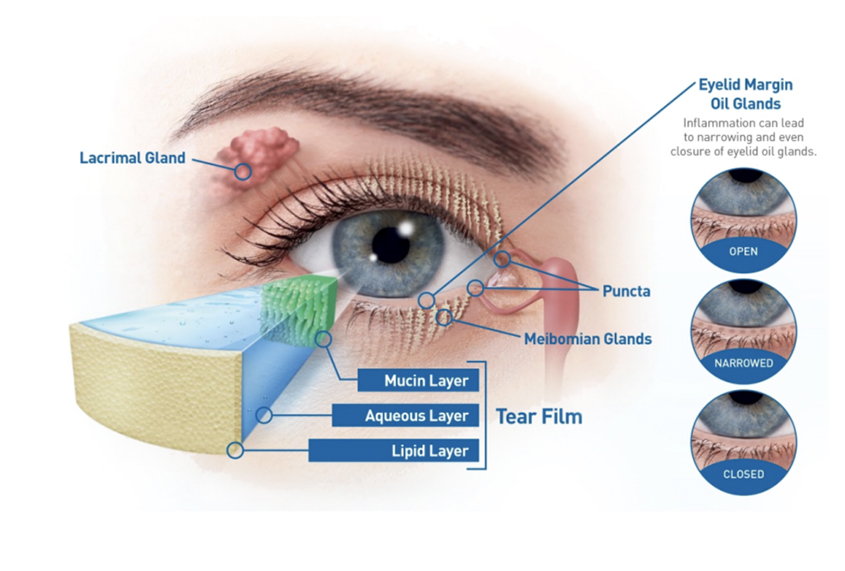What Is Dry Eye?
Dry eye isn't just about feeling "dry." It's a chronic, often progressive condition that affects the surface of your eyes, the health of your eyelids, and surrounding skin.
According to the TFOS DEWS III report, dry eye is "a multifactorial disease of the ocular surface characterized by a loss of homeostasis of the tear film, accompanied by ocular symptoms, in which tear film instability and hyperosmolarity, ocular surface inflammation and damage, and neurosensory abnormalities play etiological roles."
Key takeaway: Dry eye is complex. It involves inflammation, changes to your tear film, and sometimes eyelid or nerve function - and it needs more than just artificial tears to manage effectively.

How the Healthy Tears Work
| Layer | Function | Source |
|---|---|---|
| Lipid (Oil) | Prevents evaporation | Meibomian Glands (eyelids) |
| Aqueous (Water) | Provides moisture & nutrients | Lacrimal gland |
| Mucin | Helps tears spread evenly & stick to surface | Goblet cells |
Every blink refreshes this 3-layer system. If even one layer breaks down, your tears become unstable — leading to irritation, blurred vision, or redness.
Two Types of Dry Eye
| Layer | Function | Source |
|---|---|---|
| Lipid (Oil) | Prevents evaporation | Meibomian Glands (eyelids) |
| Aqueous (Water) | Provides moisture & nutrients | Lacrimal gland |
| Mucin | Helps tears spread evenly & stick to surface | Goblet cells |
Common contributing factors
- Blepharitis - Inflammation of eyelid margins causing redness, flaking, and irritation. Often linked to bacteria or rosacea.
- Demodex - Microscopic mites in lash follicles, seen as "dandruff" at lash bases. Cause itching, inflammation, and resistant blepharitis.
- Meibomian Gland Dysfunction (MGD) - Blocked or poorly functioning oil glands leading to rapid tear evaporation and unstable tear film. Very common in screen users, contact lens wearers, and aging adults.
- Allergies - Can mimic or worsen dry eye with itching, watering, and lid puffiness. It's important to distinguish and properly treat this confounding disease entity.
- Lagophthalmos - Incomplete eyelid closure during blinking or sleep, leaving eyes exposed.
- Cosmetic Habits - Waterline eyeliner, lash glue/extensions, and not fully removing makeup can all block glands and cause inflammation
How Dry Eye Leads to Inflammation
- Tear film becomes unstable (from lack of oil or water)
- The eye's surface dries out
- The body responds with inflammation
- Inflammation damages tissue and glands
- Symptoms worsen→ cycle repeats
- That's why we focus on breaking the cycle, not just masking symptoms.
Who Is Most At Risk?
These are patients we see every day:
- Women, especially post-menopausal
- People with heavy screen time
- Contact lens wearers
- Those with Botox, lash extensions, or eyelid surgery
- Patients using medications like antihistamines or antidepressants
- Individuals with autoimmune or hormonal conditions
What Patients Say (Even if They Don’t Say 'Dry')
Many dry eye patients won’t describe their symptoms using the word “dry.” Instead, they say:
- "My eyes feel gritty or burn."
- "My vision gets blurry at the end of the day."
- "I'm constantly using drops, but they don't help."
- "My eyes water all the time."
- "They feel tired, like I need to close them."
Our Approach at See La Vie
We don't just treat symptoms we address the root causes with a layered approach:
- At-home care Warm compresses, lid hygiene, omega-3s, and skincare designed for eye health.
- Spa treatments - Professional eyelid cleansing, tear gland heating, and gentle oil gland expression.
- Advanced therapies - OptiLight (IPL) for inflammation and redness, OptiLift (DMST + RF) for muscle tone and lid function.
This integrated approach not only relieves discomfort but also helps your eyes look brighter, healthier, and more refreshed.








